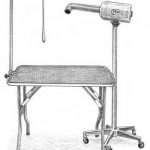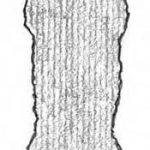Staying Prepared with First-Aid Basics

In This Chapter
- Keeping important items in a canine first-aid kit
- Trying your hand at basic first-aid techniques
- Knowing what to do in emergency situations
Hopefully you’ll never have to deal with a canine health emergency, but, as is the essence of an emergency, you can’t predict when or if one will happen. Emergencies are unexpected situations that call for quick action. Your best course of action is to follow the Scout motto and “be prepared” to act if your Poodle needs your help. In this chapter, I describe the must-haves for your Poodle’s first-aid kit; I show you how to perform basic first-aid techniques; and I explain what you can do in specific emergencies to rescue your beloved pet.
Remember
The most important thing to do in all circumstances is to get your Poodle to a veterinarian as soon as possible. First aid is just a way to control a situation until you can get professional help. Don’t spend more time on first aid than is absolutely necessary.
Stocking the Essentials in Your Canine First-Aid Kit
Tip
In your residence, designate one shelf in a cabinet for your Poodle’s first-aid supplies, or store them in a small box that can travel throughout your home. If you travel with your Poodle, you should keep a small first-aid kit in your vehicle. A tube of antibiotic ointment, some gauze pads, and some aspirin may suffice for your portable kit.
Traditional medicines
– Vet wrap and adhesive tape: Vet wrap holds bandages or splints in place, and it won’t stick to your Poodle’s hair. If you keep the hair on your Poodle’s flaps long (see Chapter Providing Your Poodle with a Nutritious Diet for more on grooming), you may already have vet wrap with your grooming supplies. If not, you can find the wrap in pet-supply catalogs and stores. Put a roll with your first-aid supplies as well. Adhesive tape can hold bandages in place, too, but it can make a mess of your Poodle’s coat and could pull hair and hurt your dog when you remove it.
– Antibiotic ointments: For use on scrapes and shallow cuts. I use a triple antibiotic cream, which is available at drug stores.
– Artificial tears: Apply to your Poodle’s irritated eyes.
– Benadryl: For allergic reactions (such as those that often come with insect stings). Give one milligram per pound of body weight.
– Betadine: You can readily find this antiseptic in the pharmaceutical department of grocery stores or in drug stores. You use it to treat minor cuts, and doctors use it to prepare the skin prior to surgery. It contains 10 percent povidone-iodine.
– Children’s aspirin: For fever or pain, adult-strength aspirin is fine for a Standard Poodle; most vets recommend buffered aspirin. You also can cut an adult tablet in half or in quarters if you don’t have any children’s aspirin for Toy or Miniature Poodles. Give one tablet for every 10 to 15 pounds of body weight.
Warning!
Don’t ever give your Poodle ibuprofen, naproxen sodium, or acetaminophen. It can be fatal.
– Cotton balls: Good for applying salves or for the external application of liquid medicines. In a pinch, a cotton ball can replace a gauze pad.
– Gauze: A roll of gauze can secure dressings on wounds your Poodle may have. You can purchase various sizes of gauze pads; the size you get depends on the wound and the size of your Poodle.
– Hemostats and/or tweezers: You use these tools to remove slivers, or large bits of debris that may be stuck in a wound. You may already have hemostats in your grooming kit for removing flap hair (see Chapter Providing Your Poodle with a Nutritious Diet for more about grooming).
– Hydrocortisone ointment: For use on bug bites or rashes.
– Hydrogen peroxide: A product used to clean and disinfect wounds. You also can use hydrogen peroxide to induce vomiting, if your dog has ingested something poisonous and you know what the substance is. If you already have a large bottle of hydrogen peroxide, you can cross syrup of ipecac off your supply list.
Remember
Hydrogen peroxide loses strength in storage. You should replace it yearly if not opened and more often if opened.
Warning!
If you suspect your dog has ingested a cleaning product, do not induce vomiting. The caustic chemicals will burn your dog’s esophagus and mouth.
– Kaopectate: Helps control diarrhea. Give one teaspoon for every five pounds of body weight, at a clip of every four hours.
– Petroleum jelly: Can sooth minor scrapes or burns.
– Rubber gloves: Can make dealing with assorted bodily fluids much nicer.
– Scissors: For cutting gauze or vet wrap.
– Syringes: You should stock 3-, 6-, and 12-centimeter syringes for administering liquid medications. They can make it easier to get your dog to swallow hydrogen peroxide or Kaopectate, for instance.
– Syrup of ipecac: Give by mouth to induce vomiting if your Poodle ingests a poison. You can find the syrup at your pharmacy.
– Thermometer: For taking your Poodle’s temperature. Normal temperature for a dog is between 100 and 102 degrees Fahrenheit.
– Veterinarian’s phone number: Keep an index card inscribed with your veterinarian’s phone number and the number of your local emergency clinic on your Poodle’s medical supplies shelf or in her first-aid kit.
– Veterinary first-aid manual: Most pet-supply stores and many book stores sell canine first-aid manuals.
Holistic medicines
– Aloe vera: A product that helps to relieve pain and itching in and around hot spots, insect bites, and other skin irritations. Along with being nontoxic, Aloe vera has a bitter taste, so it may discourage your Poodle from licking and biting at problem areas.
– Arnica gel: For use on sprains and bruises to reduce pain and swelling.
– Calendula gel: Apply this gel to scrapes and wounds to promote healing. It has antiseptic properties and can help reduce swelling.
– Cayenne pepper: You can sprinkle this pepper on a wound to stop the bleeding.
– Comfrey ointment: Good for minor scrapes and wounds. Comfrey contains allantoin, which speeds up the natural replacement of cells and promotes healing.
– Rescue remedy: A mixture of five of the single Bach essences (see Chapter Taking Basic Care of Your Poodle’s Health for more details). You use the remedy to treat shock, collapse, or trauma.
Performing Basic First-Aid Techniques on Your Poodle
Tip
Taking an animal first-aid class is a good way to prepare yourself for emergency situations. Having some basic knowledge allows you to help your Poodle until you can get to your vet’s office, and it helps you to remain calm. Many Red Cross branches offer animal first-aid classes.
Taking your Poodle’s temperature and pulse
Tip
A rectal thermometer is the way to go for taking your Poodle’s temperature. You can ask for guidance on the technique during a regular visit to your vet’s office for a checkup. Practice taking your dog’s temperature before an emergency arises.
Muzzling your Poodle
Warning!
Don’t put a muzzle on your Poodle if she’s having trouble breathing. Use a blanket, a magazine, or newspaper to wrap around your dog’s head, with the material extending beyond her muzzle. You can hold the material in place with gauze, adhesive tape, or vet wrap. A blanket or newspaper will protect you from your Poodle’s snapping jaws, but it won’t hinder your Poodle’s breathing.
1. Stand behind your Poodle or straddle her to avoid her attempts at bites while you apply the muzzle.
2. Bring the material up from under her jaw and tie a halfknot on top of her muzzle.
3. Bring the ends of the material down and tie another half knot on the underside of your dog’s muzzle.
4. Tie the ends behind your Poodle’s head. Use an easyrelease knot such as a half hitch, or tie the ends in a bow.
Moving your Poodle safely
Remember
If your Poodle has severe injuries, you need to take her to your vet’s office for emergency care. For the trip, you should consider transporting her on a blanket or a board — especially if you suspect she has spinal cord damage. You want to move her around as little as possible, and a board helps this cause.
Giving artificial respiration
1. Extend your Poodle’s neck by gently grasping her jaw and pulling forward.
2. Clear any mucus or debris from her mouth.
3. Pull her tongue forward.
4. Breathe into her nose, closing your mouth tightly over her nose holes, for three seconds.
5. Rest for two seconds.
6. Continue Steps 4 and 5 until your Poodle can breathe on her own or until you reach your vet’s office.
Tip
If you don’t want to put your mouth around your Poodle’s nose for respiration, you can use the top of a water bottle. Find a bottle appropriate for the size of your Poodle, and cut off the top below the narrow mouth. (To be prepared, you can keep a bottle at the ready with your first-aid equipment.) The bottle won’t form as effective a seal as your mouth, but it will work.
1. Place both of your hands on your Poodle’s side, near her last ribs.
2. Press down and release quickly.
3. Try to complete 12 compressions per minute, or about one every five seconds.
If you have another person with you, he or she can drive you to the veterinarian’s office while you continue with the compressions.
Remember
The compression method isn’t CPR. The compressions are to the lungs, not the heart, and are in place of breathing into the dog’s nose.
Treating shock
– Shallow, rapid breathing
– A rapid pulse rate (see the earlier section “Taking your Poodle’s temperature and pulse”)
– Pale mucus membranes
– Cool skin and legs
– Staring eyes
1. Make sure your Poodle is breathing by feeling her chest and putting your hand by her nose.
Clear her airway and start artificial respiration if necessary (see the previous section for details).
2. Wrap her in blankets, towels, or even newspapers — any material that will conserve heat.
Warning!
Never use heating pads or lamps to keep your dog warm. If they get too hot, your Poodle won’t be able to move away, and she may suffer burns.
3. Try to keep your Poodle quiet.
Don’t let her struggle or move around, even if she appears to be feeling better. Keep her quiet and warm.
4. Get your Poodle to the vet immediately.
Remember that first aid is just a means of stabilizing your dog until she can get proper medical attention.
Remember
In the event of a serious injury, treat your Poodle for shock before you see any symptoms. Don’t wait! Try to stop any serious bleeding and keep her warm and quiet until you can get medical attention.
Coming to Your Poodle’s Rescue in Specific Emergencies
Remember
If your Poodle sustains a serious injury, call your vet immediately, give him a brief description of your Poodle’s situation, and tell him that you’re on the way. You may not think you have time to make the call, but that information can help save time at the vet’s office. The call gives the vet’s staff time to prepare for your dog’s arrival and lets them know what kind of problem they’ll soon be facing.
Lacerations and bleeding
Warning!
Use a tourniquet only as a last resort — in other words, if you’re certain that your dog will die without it. A tourniquet stops the blood flow completely, and because of this, the tissue below the tourniquet starts to die. If you must use a tourniquet, tighten it only enough to stop the bleeding, and get to your vet as fast as possible.
Different types of wounds
Puncture wounds
Warning!
If the object that created the wound is still in place, don’t remove it. Pulling out the object could cause more damage and heavier bleeding. Leave it in place and let your veterinarian remove it.
Eye injuries
Internal injuries
Remember
You may not be able to see some of your Poodle’s worst wounds. If your dog gets hit by a car or gets in a fight with another dog, she may suffer some internal damage. She may look just fine, but she could have severe bruising, muscle injury, or organ damage. Your dog may go into shock (I show you how to treat shock earlier in this chapter), or her injured tissue may break down and overwhelm her kidneys. If your Poodle goes through a dangerous, traumatic situation, get her to the vet’s office for a checkup, even if she acts fine.
Broken bones
1. Protect the leg with padding.
Use any kind of soft cloth or gauze pads if you have some handy.
2. Grab a stick or a piece of wood to use as a splint. Place the splint above and below the joints on either side of the break.
You also can roll a newspaper or magazine around the broken leg. Make sure the splint extends beyond the joints on either side of the break.
3. Tie the splint in place with strips of gauze, vet wrap, nylon, or a knee-high sock.
Remember
If the broken bone is protruding from the skin, don’t try to push it back into place. Cover the protrusion with gauze, stabilize the area as well as you can, and get immediate medical attention.
Heatstroke
– Drooling
– Foaming at the mouth
– Vomiting
– Diarrhea
– A temperature over 106 degrees
– Collapsing
– Hot and dry skin
– Pale lips
1. Move her into the shade.
2. Soak her with cold water.
3. Rinse her mouth with cold water, and offer her small amounts to drink.
4. Move her legs gently to increase circulation.
5. Get to your veterinarian’s office as soon as possible.
Warning!
Waiting to see whether your Poodle’s temperature will come down could result in permanent brain damage if her temperature doesn’t drop.
Frostbite
Warning!
After an area of skin or a pad has been damaged by frostbite, the area is even more susceptible in the future. You need to take great pains to make sure you protect that area from the cold when your Poodle is outside from that point on.
Tip
Providing a sweater for winter walks may protect exposed skin (depending on how you clip your Poodle). A coating of petroleum jelly on the pads helps protect against cold and irritation from salt, or you can buy special booties for your Poodle at a pet-supply store.
Choking
1. Place the handle of a screwdriver between your Poodle’s back teeth to prevent her from chomping on your hand as you check her mouth and throat.
2. If you can see the object that’s blocking the airway, try to use your fingers or a pair of needle-nosed pliers to remove it.
3. If you can’t reach or see the blockage, lift your Poodle by her hind legs and shake her.
4. If that doesn’t dislodge the object, perform the Heimlich maneuver.
Make a fist and apply sudden, forceful pressure to her abdomen at the edge of her breastbone. Temper this action to the size of your Poodle; a Standard needs a bit more force than a Toy or Miniature.
Tip
After you remove the object, you have to deal with an aching Poodle. Her throat may be sore for a day or two, so switch to soft food or soak her kibble until she recovers.
Poisoning (including insect bites and stings)
– Abdominal pain
– Diarrhea
– Excessive drool
– Slow breathing
– Vomiting
– Weakness
Remember
Keep in mind that insect bites and stings, as well as reptile bites, are types of poison. If you notice a lump on your Poodle that seems tender or looks like a bite, and your Poodle seems ill, head for your vet’s office. If your Poodle’s breathing is labored, give her an antihistamine, such as Benadryl. You also can apply hydrocortisone to a bite or sting.
Warning!
Never encourage vomiting if you don’t know what your Poodle ingested. Many cleaning products contain caustic ingredients that can do additional damage when vomited up. If you suspect that your Poodle has ingested a household cleaner, give her milk or vegetable oil to drink before you head to the vet’s office. These products dilute the caustic substance and coat and protect your Poodle’s digestive tract.
Tip
If you suspect that your Poodle has ingested a poisonous chemical or substance, and you can’t reach your vet, find help over the phone:
– Call the Pet Poison Helpline at 800-213-6680. The charge per case is $35.
– Call the ASPCA’s (The American Society for the Prevention of Cruelty to Animals) Animal Poison Control Center at 888-426-4435. You must pay a $55 consultation fee, so have your credit card ready.
Electrocution
Warning!
If your Poodle chews through or comes in contact with a live wire, your first reaction is to grab your dog. Don’t! You risk being electrocuted along with her.
1. Turn off the power to the electrical source, if possible.
2. Use a wooden stick or a broom/mop handle to move your Poodle away from the wire.
3. Get your Poodle to the vet immediately.
by Susan M.Ewing

































